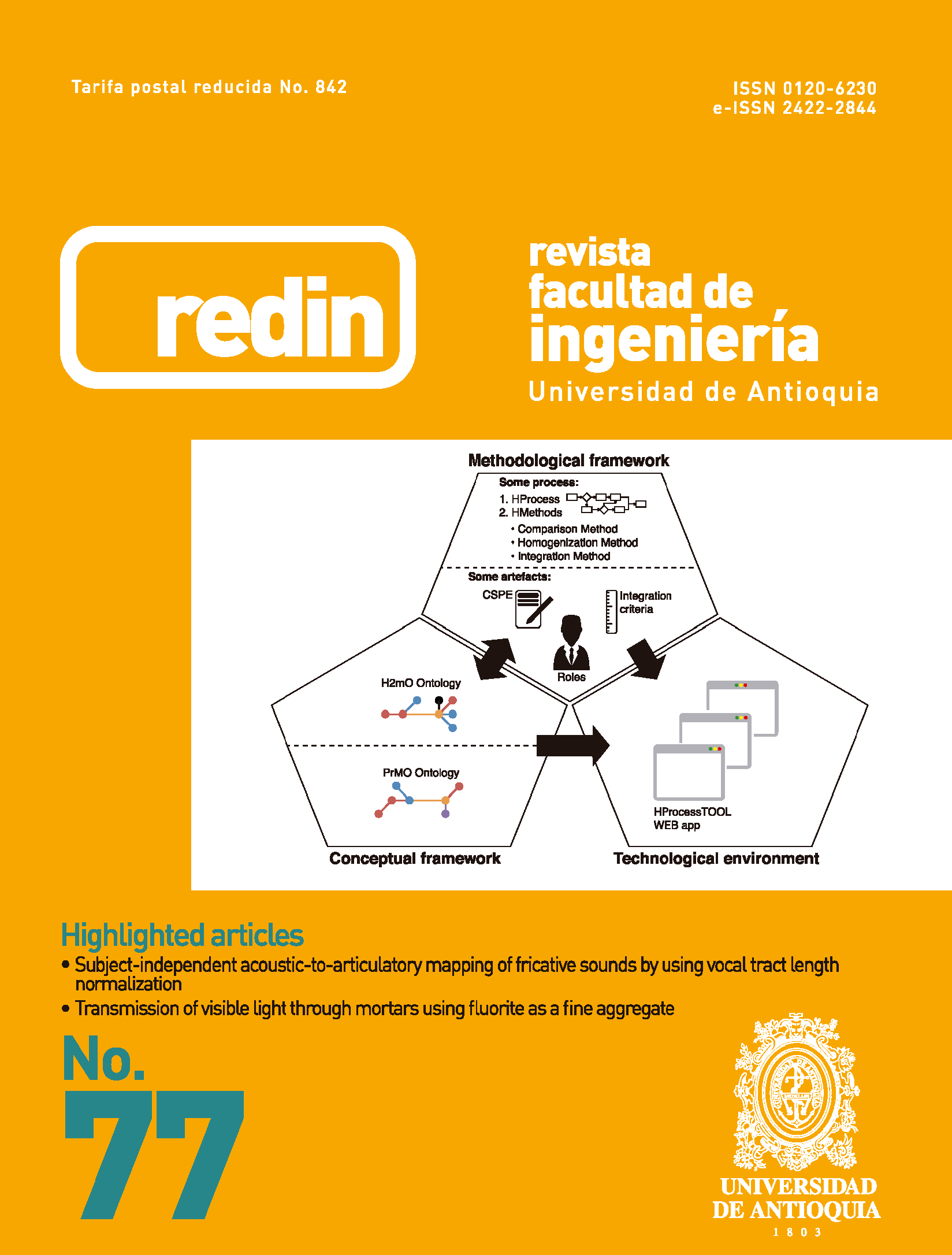Barreras para la innovación detectadas en 400 empresas colombianas, a partir de la metodología coeficiente “U” de innovación
DOI:
https://doi.org/10.17533/udea.redin.n77a02Palabras clave:
proyectos de innovación, coeficiente U de innovación, barreras para la innovaciónResumen
Las barreras para la innovación han sido estudiadas desde hace más de 40 años, sin embargo, en la mayoría de estos estudios el tema ha sido abordado de una forma cualitativa, lo que indica que se requieren herramientas que permitan cuantifi car el efecto de las barreras para la innovación dentro de las organizaciones. En esta ocasión, se presentan los resultados de la herramienta, coefi ciente “U” de innovación, desarrollada por investigadores de la Universidad Pontifi cia Bolivariana, la cual fue aplicada a 400 empresas de diversos sectores. La herramienta está conformada por un total de 18 barreras internas y externas, y permite detectar las barreras controlantes (o más importantes) por sector y región; así como un coefi ciente que clasifi ca las empresas en rangos de alto, medio y bajo en cuanto a facilidades para innovar. Sin embargo, ha surgido la necesidad de aumentar el número de barreras y de generar otros indicadores por empresa. La metodología para el cálculo de barreras para la innovación en empresas puede ser la base para la medición de los obstáculos de innovación en regiones, cluster y sectores, ya que reflejaría un indicador de las barreras más representativas en cada uno de ellos y sería útil para generar estrategias eliminar esas barreras a través de políticas públicas y convocatorias con proyectos específi cos que permitan la eliminación de las barreras para la innovación.
Descargas
Citas
E. Rigby, A. McCoy and M. Garvin, “Toward Aligning Academic and Industry Understanding of Innovation in the Construction Industry”, International Journal of Construction Education and Research, vol. 8, no. 4, pp. 243-259, 2012.
E. Pellicer, C. Correa, V. Yepes and L. Alarcón, “Organizational Improvement Through Standardization of the Innovation Process in Construction Firms”, Engineering Management Journal, vol. 24, no. 2, pp. 40-53, 2012.
D. Simon and D. Rehn, “Innovation in China’s semiconductor components industry: The case of Shanghai”, Research Policy, vol. 16, no. 5, pp. 259-277, 1987.
S. Jasanoff, “Technological innovation in a corporatist state: The case of biotechnology in the Federal Republic of Germany”, Research Policy, vol. 14, no. 1, pp. 23-38, 1985.
I. Booyens, N. Molotja and M. Phiri, “Innovation in High-Technology SMMEs: The Case of the New Media Sector in Cape Town”, Urban Forum, vol. 24, no. 2, pp. 289-306, 2013.
F. Zhao, “Technological and organisational innovations: Case study of Siemens (Australia)”, International Journal of Innovation and Learning, vol. 3, no. 1, pp. 95-109, 2006.
M. Christie and R. Garrote, “Barriers to innovation in online pedagogy”, European Journal of Engineering Education, vol. 34, no. 3, pp. 273-279, 2009.
J. Rutkowski and K. Moscinska, “Barriers to innovation in e-pedagogy: A case study”, in 13th International Conference on Computers and Advanced Technology in Education, Maui, USA, 2010, pp 146-151.
C. Mirow, K. Hoelzle and H. Gemuenden, “The ambidextrous organization in practice: Barriers to
innovation within research and development”, in 68th Annual Meeting of the Academy of Management, Anaheim, USA, 2008, pp 1-6.
K. Vandenbempt and P. Matthyssens, “Barriers to strategic innovation in industrial markets”, Advances in Business Marketing and Purchasing, vol. 13, pp. 701-723, 2004.
P. D’Este, S. Iammarino, M. Savona and N. Tunzelmann, “What hampers innovation? Revealed barriers versus deterring barriers”, Research Policy, vol. 41, no. 2, pp. 482-488, 2012.
A. Madrid, D. Garcia and H. Auken, “Barriers to Innovation among Spanish Manufacturing SMEs”,
Journal of Small Business Management, vol. 47, no. 4, pp. 465-488, 2009.
A. Cordeiro and F. Vieira, “Barriers to innovation in smes: an international comparison”, in II Conferência Internacional de Integração do Design, Engenharia e Gestão para a inovação, Florianópolis, Brazil, 2012, pp. 10.
H. Righi, F. Salum, R. Reis and R. Pereira, “The Barriers to Innovate in Brazil”, in 22nd International Conference on Management of Technology (IAMOT), Porto Alegre, Brazil, 2013, pp. 17.
N. Lagziri, H. Achelhi, M. Bennouna and P. Truchot, “Barriers as determinants of innovation in Morocco: The case of Tangier-Tetouan region,” International Journal of Innovation and Applied Studies, vol. 4, no. 1, pp. 203-221, 2013.
Management Innovation Lab, Harvard Business Review Blog Network, 2007. [Online]. Available: http://blogs.hbr.org/hbr/hamel/flatmm/miw_tool.pdf. Accessed on: Feb. 12, 2007.
J. Zartha, B. Arango, D. Coy, J. Gonzalez and E. Jaramillo, “Methodology to calculate the integral coefficient of Innovation ‘U’ in organizations”, in 22nd International Conference on Management of Technology (IAMOT), Porto Alegre, Brazil, 2013, pp. 17.
Descargas
Publicado
Cómo citar
Número
Sección
Licencia
Derechos de autor 2015 Revista Facultad de Ingeniería Universidad de Antioquia

Esta obra está bajo una licencia internacional Creative Commons Atribución-NoComercial-CompartirIgual 4.0.
Los artículos disponibles en la Revista Facultad de Ingeniería, Universidad de Antioquia están bajo la licencia Creative Commons Attribution BY-NC-SA 4.0.
Eres libre de:
Compartir — copiar y redistribuir el material en cualquier medio o formato
Adaptar : remezclar, transformar y construir sobre el material.
Bajo los siguientes términos:
Reconocimiento : debe otorgar el crédito correspondiente , proporcionar un enlace a la licencia e indicar si se realizaron cambios . Puede hacerlo de cualquier manera razonable, pero no de ninguna manera que sugiera que el licenciante lo respalda a usted o su uso.
No comercial : no puede utilizar el material con fines comerciales .
Compartir igual : si remezcla, transforma o construye a partir del material, debe distribuir sus contribuciones bajo la misma licencia que el original.
El material publicado por la revista puede ser distribuido, copiado y exhibido por terceros si se dan los respectivos créditos a la revista, sin ningún costo. No se puede obtener ningún beneficio comercial y las obras derivadas tienen que estar bajo los mismos términos de licencia que el trabajo original.










 Twitter
Twitter